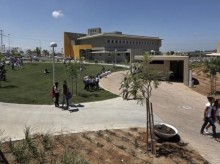Anti-rocket school protects Israeli kids near Gaza
 Israeli high-school students walk through the yard next to a new rocketproof school building. (AP Photo/Tsafrir Abayov)
Israeli high-school students walk through the yard next to a new rocketproof school building. (AP Photo/Tsafrir Abayov)
SDEROT, Israel (AP) — For the first time in years, the children of Sderot can study in peace.
Living under a constant threat of rocket fire from militants in the nearby Gaza Strip, their schooldays were often interrupted by mad dashes to bomb shelters. But on Monday, they started the school year safe from attack in a new, fortified, rocket-proof school building.
The $27.5 million structure features concrete walls, reinforced windows and a unique architectural plan all designed specifically to absorb and deflect rocket fire. Notices on the walls of the ‘‘Shaar Hanegev’’ High School remind the 1,200 students of their new reality: In case of a warning siren, it reads, stay put.
‘‘You can finally teach without constantly worrying about what to do when there is a rocket attack,’’ said Zohar Nir-Levi, the principal of the junior high school inside the complex. ‘‘You can concentrate on your studies. It used to be that even before you said hello in the morning you were telling people where to run.’’
In the 12 years since rockets began raining down on Sderot, less than a mile (2 kilometers) from Gaza, residents say life has often been unbearable. Eight people have been killed, hundreds wounded and nearly everyone in the working-class town of some 24,000 has been traumatized by the frequent wail of sirens and explosions.
Schools were often shut for periods during this time, with parents fearing for the safety of their children. Psychologists treated many kids for trauma. In one memorable incident, a rocket hit an empty school, sparking demands for better protection.
Alon Shuster, chairman of the regional Shaar Hanegev council, said the decision to build the new school was made as ‘‘a strategic response to a threat we have been coping with for 12 years.’’
The rocket fire has subsided considerably in the past three years, since Israel carried out a fierce three-week offensive against Gaza militants in which some 1,400 Palestinians, including hundreds of civilians, were killed. Gaza’s Hamas rulers have largely halted their rocket fire at Israel since then, though smaller armed groups continue to stage attacks.
The Israeli military says some 440 rockets have been fired so far this year. In a fresh reminder, two rockets fell in the area on Monday, following a similar barrage a day earlier. No one was hurt.
Over the years, authorities have scrambled to protect the town’s schools, reinforcing buildings with concrete barricades and stronger roofs. A heavily fortified elementary school was also built, as was a special indoor playground with a mini-soccer field, video games and bomb shelters, according to local officials.
But officials say the new high school takes protection to a new level. The school, built on a sprawling campus, took two years to plan and then two more years to construct.
Each grade has its own color-coded building, with colorful tiles lining the floors. It features concrete shelters in the school yard as well, to allow students on recess to find cover in the 15-second window they have between the sound of the siren and the landing of the rocket. A science lab and an auto shop are fortified. Even the angles of the buildings are specially built to deflect incoming projectiles.
‘‘The walls are thick, the windows are very thick too,’’ said Yuval Gani, the architect who designed the school. ‘‘The doors are protected, the roof is protected also. … The facade of the building, its task is to deviate the missiles.’’
Israel is by no means the only place where children come into danger when they go to school. In areas of Colombia wracked by guerrilla violence, schools have intentionally been located far away from police stations, which often become targets. In Iraq, police patrols stand near schools, and some roads leading to schools are blocked with barbed wire or concrete walls. A small upper crust in Baghdad is able to live and send its children to school inside the heavily fortified Green Zone.
The students appear to appreciate their new home.
Michael Spitzer, an 11th grader, said the protection of the building made him less concerned about his younger sister, who also studied there and his mother, who is a teacher.
‘‘I don’t have to worry about them anymore,’’ he said. ‘‘I can just focus on school and not all the other stuff.’’
Israeli President Shimon Peres attended the school’s grand opening Monday and praised the children’s resolve.
‘‘I see here a wonderful and strong stance in the face of rockets,’’ he said, seated in a ninth-grade classroom. ‘‘This fortified school inaugurated today is the least that can be done for you. In response to the rockets you are making a strong statement.”
 Contact aron
Contact aron RSS SUBSCRIBE
RSS SUBSCRIBE ALERT
ALERT